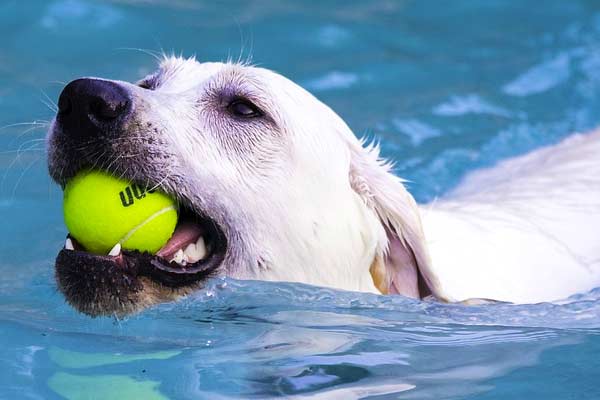Can Greyhounds Swim? Discover the Surprising Truth
Do you have a greyhound and want to know if it can swim? If so, you’ll be delighted to know that while all dogs can swim, greyhounds may need extra help to become comfortable in the water.
This blog post will explore how to properly introduce your greyhound to the pool and provide exercises to help build their confidence.
With patience and dedication, your furry friend will soon be enjoying all the benefits of aquatic activities! So grab your towel – it’s time for an adventure!
Can Greyhounds Swim?
Greyhounds can swim but may need extra help to become comfortable in the water. Their size and low stamina make them less adept swimmers than many other breeds, so it’s essential to take things slow and use positive reinforcement when teaching your dog how to swim.
Are Greyhounds Good Swimmers?
No, greyhounds are not natural swimmers because their long, slender bodies can easily overwhelm them, and they may want to avoid going in the pool initially.
Are Greyhounds Scared of Water?
Yes, it is normal for a greyhound to be scared of the water at first, as they are not natural swimmers and can quickly become overwhelmed by the sensation. Many greyhounds show hesitance or even fear when introduced to the pool or any body of water.
Safety Tips for Teaching a Greyhound to Swim
1. Start slow and use positive reinforcement to encourage your greyhound to swim. Begin by introducing your dog to shallow water, such as a kiddie pool or bathtub. Let them get used to the sensation of the water on their feet before gradually moving deeper into the pool. Offer treats and lots of praise for being brave.
2. Use a life vest or other flotation device when introducing your dog to the pool. This will provide extra confidence and security, helping your greyhound learn faster.
3. If you can’t access a pool, use a lake, stream, or pond instead. The shallower water is more manageable for dogs to navigate and can be a great way to help them get used to swimming in the water.
4. Take plenty of breaks and watch for signs of fatigue or distress. If your greyhound starts to tire, offer support like noodles, life vests, or even a dog pool float for an extra boost.
5. Teach your dog how to exit the pool by introducing them to a sturdy ladder or steps. This will help ensure that your greyhound can get out of the water if they get tired or feel overwhelmed.
Exercises That Can Help Improve Their Swimming Abilities
1. Ensure that your greyhound gets plenty of exercise when on land by walking or playing fetch to build stamina, help them stay strong in the water, and provide a solid foundation for learning how to swim.
2. Start slowly with exercises like “doggie paddle” – have your dog stand in shallow water and start paddling their front legs in the same motion as a breast stroke while you provide support at their chest.
3. Gradually introduce them to deeper water, such as a pool or lake. Ask them to swim short distances while offering treats and praise for every successful attempt.
4. Once your greyhound is confident in the water, try adding games and tricks that can help increase its speed and agility. From fetching toys to doggie dives, there are plenty of fun ways to make swimming an enjoyable experience for you and your pup.
Do Greyhounds have Webbed Feet? Do they help?
Do Greyhounds have Webbed Feet?
No, greyhounds do not have webbed feet. Greyhounds typically have regular, non-webbed feet, with their thin and long bodies making them less adept swimmers than other breeds.
Some dog breeds, such as Labrador Retrievers and Newfoundlands, are known to have webbed feet, which can help them in the water.
Do Webbed Feet Help Dogs in the Water?
Yes, webbed feet can help a dog swim faster and more efficiently by providing more surface area for pushing against the water. Webbed feet help dogs move in the water with better speed and agility, making them ideal swimmers for competitive sports such as dock diving and flyball.
What are the Top Swimming Dog Breeds
The top swimming dog breeds have a natural affinity for the water and love to exercise.
Some breeds may need extra help to become comfortable in the water, while others take to it like a fish to water! Here are some of the best swimming dog breeds:

1. Labrador Retriever: Labradors are known for their love of swimming and playing in the water. With their thick, waterproof coats and webbed feet, these dogs make excellent swimmers and water retrievers.
2. Portuguese Water Dog: Well-suited to activities in the water and help fishermen with tasks like retrieving nets and herding fish.
3. Chesapeake Bay Retriever: They bred to retrieve waterfowl and have a natural affinity for the water. They are strong swimmers with excellent agility and endurance in the water.
4. Newfoundland: With its thick coat, webbed feet, and powerful swimming muscles, this breed is natural in the water. Newfoundlands are known for their strength and endurance, making them great swimmers.
5. Irish Water Spaniel: Bred to hunt ducks and retrieve game from lakes and rivers. It is an excellent swimmer with webbed feet, a waterproof coat, and powerful hind legs that help propel it through the water.
6. Golden Retriever: With its strong swimming muscles and love of the water, this dog is a natural swimmer. It is an excellent water retriever that can easily retrieve an object from underwater.
7. Poodle: Poodles are known for their intelligence and agility in the water, making them great swimmers. They have webbed feet and a waterproof coat which helps them stay afloat in the water.
8. American Water Spaniel: Bred for hunting, particularly on land and water. An excellent swimmer with webbed feet, a thick waterproof coat, and powerful hind legs that help propel it through the water.
9. German Shorthaired Pointer: An excellent swimmer with a natural affinity for water. Its webbed feet, thick coat, and powerful hind legs help it to stay afloat and move quickly through the water.
10. Barbet: Best to hunt waterfowl, and they have a natural affinity for the water. Their webbed feet and thick waterproof coats help them stay afloat and make them strong swimmers.
Conclusion
Overall, greyhounds have the physical capability to swim but may be less adept than breeds such as Labrador Retrievers and Newfoundlands with webbed feet.
If your greyhound is hesitant in the water or needs extra help becoming comfortable swimming, there are plenty of fun ways to make it an enjoyable experience for you and your pup. With patience and practice, any dog can learn how to enjoy a day at the beach or pool!
Whether you choose one of these top swimming breeds or prefer another breed altogether, remember that all dogs need supervision when they’re around bodies of water. So grab a life jacket (for them!) and get ready for a splash-filled adventure!






